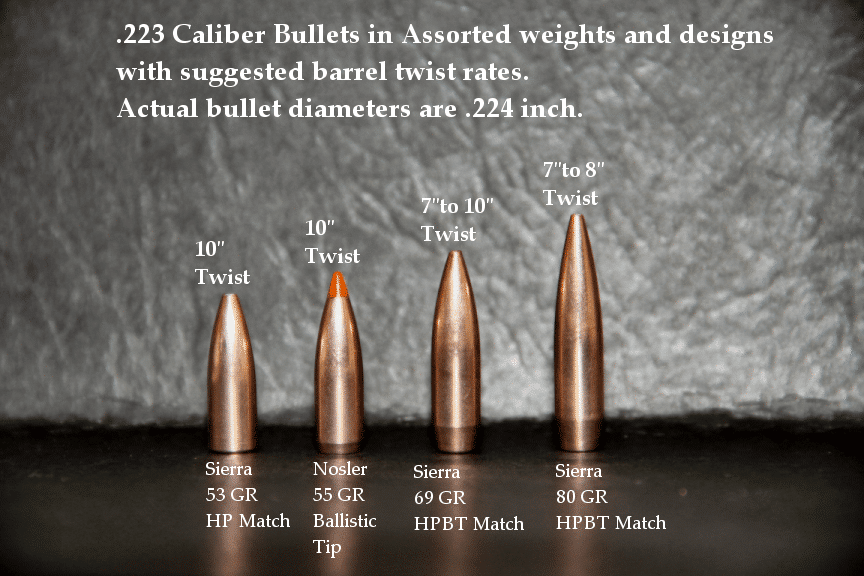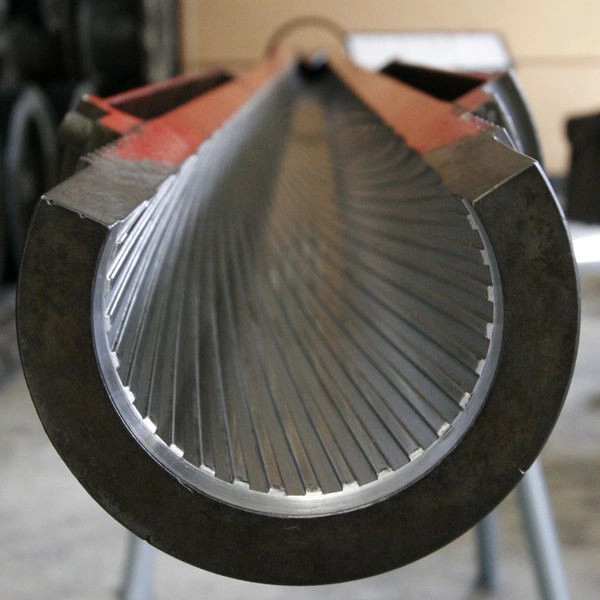A preface to twist: rifling
Before we talk too much about twist rates, we also need to talk about rifling – the mechanism that creates the twist.
Rifling refers to the groove in a barrel of a firearm which causes the bullet to spin as it leaves the firearm. Spin creates a gyroscopic force which in turn stabilises the projectile while in the air – it’s similar to the concept behind spinning a wheel and holding it by its axis – it naturally want’s to return to an up and down alignment – the spin is creating its own stability.
Twist – imperial strikes again!
Twist rate is the distance the rifling takes to complete one full revolution – expressed in inches – i.e. 1 in 10, 1 turn in 10 inches. Shorter is faster and imparts a faster spin rate.
Bigger Bullets, more spin required
Generally, the bigger (longer, which means heavier) the projectile, the more spin it is going to require to stabilise it. A 168 grain projectile is going to need a much short twist rate than a 60 grain.
When it comes to design considerations, manufacturers will often match a barrel and caliber so that the twist rate is going to be suitable to stabilise the majority of projectiles the owner is likely to want to shot through it.
To little twist rate and the bullet can start to tumble mid flight – the results in keyholing targets – where the bullet cuts rectangular shaped holes in the paper. Accuracy also goes out the window. Too high and you can start damaging the barrel and potentially cause the projectile to basically self destruct mid flight as the jacket starts to spin apart.

Did you know your bullet is actually bigger than your barrel?
It’s an interesting thought. When we pull the trigger, pressure quickly builds and results in the projectile heading at high speed down the throat towards the rifling. At this point it will have expanded slightly from the pressure and enters the rifling. The projectile now gets ‘engraved’ by the rifling – beginning the spin.
This is why some firearms have freebore – freebore helps keep the pressures low by having the gas expand before the projectile engraves. However, minimising this freebore can mean more accuracy – it reduces the potential for the projectile to distort before entering the rifling.
Getting the right twist rate
For most off the shelf rifles – twist rate is going to be already matched to common projectiles by the manufacturer. However, if you have a specific use in mind, which can lead to a specific bullet weight, then it won’t hurt to also check that the twist rate is going to be optimal.
These days there are plenty of online calculators (such as here) – the formula used is called The Greenhill Formula.
T=150(d/r), where T is the twist rate, d is the bullet diameter, and r is the bullet length to diameter ratio (bullet length divided by its diameter). For cartridges with a muzzle velocity of more than 2,800 fps, substitute 180 for 150.
Let’s use a common example – .308 168 grain Sierra Matchkings. That’s .308 diameter and 1.210 long. 3.929 ratio.
T =150 x (.308/3.929) = 150 x 0.078 =11.76
That’s an ideal twist rate of 1:11.76 – close to 1:12 – a common twist rate for .308 rifles.
That’s a match for my new Rem700 Varmint in .308 – also why I am going to start my reloads based on a 168 Sierra Projectile. It also means I likely won’t have much luck going any heavier in projectiles.
Common twist rates by calibre
.17 HMR = 1 in 9″ .22 Long Rifle = 1 in 16″.222 Remington = 1 in 14″
.223 Remington = 1 in 12″
.22-250 Remington = 1 in 14″
.243 Winchester = 1 in 10″
6mm Remington = 1 in 9″
.240 Wby. Mag. = 1 in 10″
.25-06 Remington = 1 in 10″
.257 Wby. Mag. = 1 in 10″
6.5×55 Swedish Mauser = 1 in 7.5″
.260 Remington = 1 in 9″
.264 Win. Mag. = 1 in 9″
.270 Winchester = 1 in 10″
.270 WSM = 1 in 10″
.270 Wby. Mag. = 1 in 10″
7×57 Mauser = 1 in 9″
7mm-08 Remington = 1 in 9.25″
.280 Remington = 1 in 9.25″
7mm WSM = 1 in 9.5″
7mm Rem. Mag. = 1 in 9.25″
7mm Wby. Mag. = 1 in 10″
.30 Carbine = 1 in 16″
.30-30 Winchester = 1 in 12″
.308 Winchester = 1 in 12″
.30-06 Springfield = 1 in 10″
.300 WSM = 1 in 10″
.300 Win. Mag. = 1 in 10″
.300 Wby. Mag. = 1 in 10″
7.62×39 Soviet = 1 in 10″ (Ruger)
.303 British = 1 in 10″
.32 Win. Spec. = 1 in 16″
8×57 JS Mauser = 1 in 9.25″
.338 Win. Mag. = 1 in 10″
.340 Wby. Mag. = 1 in 10″
.357 Mag. = 1 in 16″
.35 Remington = 1 in 16″
.35 Whelen = 1 in 16″
.350 Rem. Mag. = 1 in 16″
.375 H&H Mag. = 1 in 12″
.378 Wby. Mag. = 1 in 12″
.416 Rem. Mag. = 1 in 14″
.416 Wby. Mag. = 1 in 14″
.44 Rem. Mag. = 1 in 20″
.444 Marlin = 1 in 20″
.45-70 Govt. (Marlin and Ruger rifles) = 1 in 20″
.450 Marlin = 1 in 20″
.458 Win. Mag. = 1 in 14″
.460 Wby. Mag. = 1 in 16″


